Top News
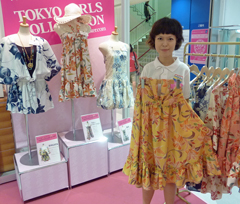
July 14, 2012 Ryukyu Shimpo
On July 13 at the Ryubo Department Store in Naha, the Prefectural Clothing and Garment Manufacturing Industrial Cooperative released three styles of women’s clothing under the new brand “Kariyushi Style” and held a small sale. The Cooperative also announced that this April they obtained a trademark for Kariyushi in China, Hong Kong, and Taiwan. Hereafter the Cooperative will search for ways to develop the market.
While Kariyushi-style wear has become popular both in and outside of Okinawa, people tend to see it as men’s or male business-wear. Kariyushi Style was created with the idea of targeting women in their twenties and thirties. The products were awarded the first, second, and third places in the Second Kariyushi Style Design Contest and presented at the Tokyo Girls Collection. Until July 31, a total of 72 pieces in three styles were offered for limited sales. The price is 8400 yen including tax.
Akihiko Higa, a researcher of Kaiho Soken who has worked in this project, said, “It is easy-to-wear and highly functional for wearing either in an office situation or in a resort. We would like to strategically spread this new brand as being different from Kariyushi wear.”
Last April, the Cooperative received transfer registration of the brand mark Kariyushi from the Prefectural Industrial Association. The label stating “Kariyushi” has been given with a certification of “Made in Okinawa Kariyushi Wear” only to those goods manufactured in Okinawa.
Obtaining trademarks in Taiwan, Hong Kong and China will lead to market deployment opportunities and serve as a countermeasure to copied products.
(English translation by T&CT, Megumi Chibana and Mark Ealey)
Go to Japanese
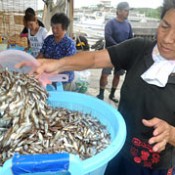
July 20, 2012 Ryukyu Shimpo
On July 19, which is June 1 in the old lunar calendar, at Ojima in Nanjo, baby rabbitfish, called suku, were caught. Fishermen managed a good catch with about 360 kilograms being hauled in this day. Suku are about three to four centimeters long and have a bright silver body. It is referred to as “the bonus from the ocean” because the fish can only be caught for a limited period of time. The large catch of this valuable fish excited people living on the island.
Local fishermen haul in the suku around the period from June 1 to July 1 in the old lunar calendar. When the boats that have finished fishing come back to the island, as the men unloaded their catch of suku local women who had been waiting anxiously for them smiled with satisfaction.
Kazuya Minei, who had been out fishing, said, “We managed a big catch of suku. I feel rewarded this time because there are often days when we cannot catch any fish despite being out on the sea the whole day.”
(English translation by T&CT, Mark Ealey)
Go to Japanese

Go To Video
July 19, 2012 Ryukyu Shimpo
On July 18, in the Okinawa Prefectural Assembly building, an executive committee was established to organize a protest rally against the deployment of the MV-22 Osprey vertical take-off and landing transport aircraft to MCAS Futenma. The committee plans to hold the rally at the Ginowan Seaside Park Multi Purpose Square at 3:00pm on August 5, and hopes to attract more than 50000 participants. On August 7 and 8, the committee will ask the Prime Minister, Foreign Minister, Defense Minister, and the U.S. forces in Japan to cancel the deployment of the Osprey and hand over the resolution adopted at the rally to each of the ministers and will consider making a request to the U.S. government.
The committee currently consists of 29 organizations in Okinawa. Economic organizations in the prefecture are considering taking part.
Masaharu Kina, the chairman of the Prefectural Assembly, Takeshi Onaga, the head of the Mayor’s Association, and Kiku Taira, the head of the Prefectural Women’s Federation, Nobumasa Nakamura, the head of the Okinawa Branch of the Japanese Trade Union Confederation, all became co-representatives. The committee will request that about 1700 organizations participate in the rally as co-hosts.
During the rally, co-representatives will deliver speeches, the mayor of Ginowan, which hosts Futenma Air Station, and heads of the various municipalities where the Osprey squadrons will carry out training, will all give their opinions. After that, the resolution of the rally will be adopted. The committee is asking Okinawa Governor Hirokazu Nakaima to deliver a speech instead of requesting that he become a co-representative. In the afternoon on July 18, at the Okinawa Prefectural Office, a representative of the committee visited Vice-governor Kanetoshi Yoseda to request the governor’s participation in the rally.
Masaharu Kina, the chairman of the Prefectural Assembly, said, “We will use this rally as an opportunity to take a stand towards the Japanese and the U.S. governments in the hope that we can prevent the deployment of the Osprey. I want the people of Okinawa to use this rally to focus their indignation and create the momentum we need to accomplish our goal.”
A press conference was held after the committee was officially established. In regard to Prime Minister Yoshihiko Noda having stated that the Japanese government could not refuse the Osprey deployment plan put forward by the U.S. government, Onaga said, “Noda’s remark reflects the fact that the Japanese government cannot refuse U.S. government requests.” He went on to say, “On this issue, we will do our best to question the actions Japan takes as an independent nation.”
On July 26, the committee will meet again to propose a resolution for the rally. From now, the committee will distribute posters and flyers advertising the rally, and put out full-page ads in two major newspapers in Okinawa.
(English translation by T&CT, Mark Ealey)
Go to Japanese
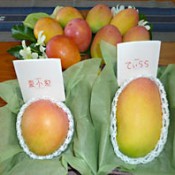
July 13, 2012 Ryukyu Shimpo
On July 12, the Agriculture, Forestry and Fisheries Department (AFFD) of the Okinawa Prefectural Government (OPG) announced two new varieties of Okinawan mango called natsukobeni and tilala. They are the first mangoes to be brought from the United States and then developed in Japan. The OPG registered both trademarks in June and will increase production volume and work to strengthen the brand power of Okinawan mangoes. The production volumes for this term are expected to be 1680 kilograms (3704 pounds) for natsukobeni and 440 kilograms (970 pounds) for tilala.
The difference between the two varieties of mangoes is that natsukobeni has round fruit and is very sweet and tilala has an oval-shaped fruit and a sweet-sour taste. The harvest season is from late July to early September, which is between the end of harvest time for the Irwin variety and the beginning of the picking season for Keitt, other mangoes grown in Okinawa. The OPG expects that the new varieties will lengthen the harvest season and increase the total production volume of Okinawan mangoes.
The new varieties are lipense for natsukobeni and Valencia pride for tilala.
The AFFD has grown 18 varieties of mangoes from cuttings sent by the United States Department of Agriculture in 2003. They selected these two varieties because of their suitability to the environment in Okinawa, and have bred them on a trial basis at Nakijin and in Miyako-jima since 2007. Targeting more affluent people and repeat customers, this year it will start to sell the mangoes.
The production volume in five years time is expected to be 100 tons for natsukobeni, and 71 tons for tilala. Takeshi Chinen, the head of AFFD said, “We aim to produce these mangoes as an original Okinawan brand and hope that this will help to increase farmer’s income. We hope that areas producing mangoes will develop in the future.”
(English translation by T&CT, Lima Tokumori and Mark Ealey)
Go to Japanese
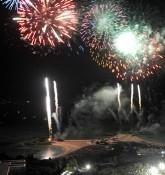
July 15, 2012 Ryukyu Shimpo
On July 14, the Summer Festival 2012 was held at the Ocean Expo Park in Motobu. About 48300 people enjoyed an exciting fireworks show.
The highlight of the event was the Niagara in which the fireworks ran about 300 meters along a wire suspended in the air. When the fireworks were lit, colorful flashes came showering down on the heads of the people. The audience also enjoyed a live music performance prior to the fireworks show and a countdown to the fireworks.
(English translation by T&CT, Mark Ealey)
Go to Japanese
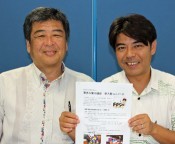
July 16, 2012 Ryukyu Shimpo
From August 11 to 18, Iheya Village is scheduled to hold a summer intensive course entitled “Tokyo University Cram School on Iheya,” in which University of Tokyo students are invited to teach junior high school students on Iheya Island. The project aims to improve the academic standards of children on the island, and to promote exchange with other junior high school students outside of the island. In addition to the study sessions, the course includes an experiential learning program unique to the island. The village also invites children from outside the island to participate in the course.
For the last two years the village has held these courses, using part of revenue to develop the area in a manner that takes advantage of materials unique to the island. This year they have also advertised for participants from outside of the island.
The course needs a minimum of ten students enrolled in order to run. Each pays a total of 50000 yen, which includes the cost of accommodation, boat fares and meals. The students will study in the intensive course in the morning, and join the experiential learning program in the afternoon. The participants will stay at the local community center. Some of them will homestay with local residents.
Four freshman and sophomore students from the School of Liberal Arts at the University of Tokyo will visit the island. All of nine local third graders, as well as the first and second graders who are interested in the course will participate in the course.
Takenori Naka, a senior staff member of the General Coordination Division of the village office, said, “Even though we managed to improve pupils’ motivation to study last year, we have not provided them with many opportunities to exchange with other children from outside of the island. When children turn 15 years old, they leave the island to further their education. I think it is important for them to have opportunities to meet other children from outside of the island because they need to have a clear idea of what leaving the island means.”
Osamu Ishihara, executive head of the Consumer Co-operative Okinawa, which supports the project, said, “I was involved in the Development Committee of the Village Comprehensive Plan. I sense the village mayor’s enthusiasm for this project.”
In the national competition for regional contribution by cooperative corporations, Consumer Co-operative Okinawa won the top award for an economic development project to solve problems of local communities through production for local consumption. The village runs the summer intensive course as part of this award-winning project.
The application deadline for the course is July 20. For further details and application, call the Commerce and Tourism Division of Iheya Village Office at 098 (046) 2177.
(English translation by T&CT, Mark Ealey)
Go to Japanese
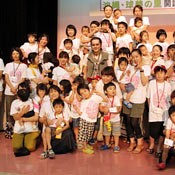
July 10, 2012 Yoko Morinaga, Correspondent of Ryukyu Shimpo
On July 8, at the Kumejima Gushikawa Farmer’s Environment Improvement Center, an opening ceremony was held for the Okinawa Kumi no Sato, the first resort facility in Japan to receive children from Fukushima who experienced the Great East Japan Earthquake. A total of 320 people celebrated the establishment of the facility, including 50 families in the first group, those people involved the project and local residents.
In the ceremony, people enjoyed performances by the brass bands of Kumejima-Nishi Junior High School and Kumejima High School. In addition, the people in the audience were cheered up listening to Okinawan folk songs played by a family-run cram school called the Nankuru, and a heartfelt performance by artist Tatsuya Ishi of a song that he wrote for the areas stricken by disaster.
Hitomi Yasuoka, representative of the families from Fukushima, said, “I am very happy that I can be safe during our stay in this island. This is very moving support for the mothers from Fukushima. We really appreciate it.”
Mayor of Kumejima Choko Taira said, “I would like children to be refreshed while they are here with us on the island and to pursue their dreams after returning to Fukushima.”
Ryuichi Hirokawa, a photojournalist and the promoter of the project, said, “We need more support from the community and many people to keep this project going here.”
The facility has a large hall in which people can have meals and 13 quadruple rooms with bunk beds. Transportation and accommodation costs are provided by the foundation.
(English translation by T&CT, Lima Tokumori and Mark Ealey)
Go to Japanese

July 15, 2012 Hideki Matsudo of Ryukyu Shimpo reports from Washington D.C.
Objections have arisen within the U.S. military with regard to the introduction of MV-22 Osprey vertical take-off and landing transport aircraft. In 2007, officers enrolled at the Naval Postgraduate School in California published an MBA report entitled “Tilt-Rotor or Helicopter?” The authors questioned the Osprey aircraft’s flying capabilities in comparison to those of the EH-101 helicopters in terms of cost-performance and cost-effectiveness, and concluded that the Osprey is not the “best” option to meet the Marine Corps’ medium-lift aviation needs.
The co-authors of this report are Stuart Day, a lieutenant commander in the United States Navy, Karl Stoetzer, a major in the Marine Corps and Roel Zamora, an air force major. The project was designed to evaluate whether or not the Osprey is the best choice of aircraft to meet the Marine Corps’ medium-lift assault support needs, and its goal was to base the evaluation on unbiased research using the methods and techniques learned in the Naval Postgraduate School’s MBA core curriculum.
With regard to the deployment to Okinawa of Osprey aircraft, Foreign Minister Koichiro Genba said that compared with the current CH-46 helicopter, “The Osprey aircraft is superior, with twice the speed, three times the payload and four times the radius range. It can increase the capability for deterrence.” The Japanese government believes that the deployment of the Osprey aircraft helps to increase U.S. military power as a deterrent to the growing threat of China and North Korea. The Ministry of Defense has created a map indicating that the Senkaku Islands (also known as the Diaoyu Islands), Taiwan, and China are within the flight range of the Osprey aircraft. However, this map may mislead people to think that the aircraft may fly directly from Okinawa to neighboring countries.
While the three co-authors acknowledge the Osprey’s superior speed, they estimate that its range advantage over helicopters is minimal because most missions flown are in close proximity to the main operating base. Referring to accidents during previous flights, the aircraft’s de-icing system was shown to be inadequate, resulting in an emergency landing. The report indicated that rather than taking advantage of the MV-22’s long-range self-deployment capability, the Marine Corps has chosen to ferry them over on U.S. Navy multipurpose amphibious assault ship to avoid dangerous icing conditions.
However, the report made it clear that the MV-22’s range advantage has not been utilized and that it relied on amphibious assault ships.
The officers sent to study at the Naval Postgraduate School carried out their evaluation based on a comparative analysis of the MV-22 Osprey and the EH-101 helicopter using data on mobility, survivability, reliability and procurement cost. The report indicated that the MV-22’s advantage in speed is of minimal value. The EH-101 has similar troop and cargo carrying capacities. The aircraft is also a good choice because it is already flown by military organizations around the world, including the Canadians, Italians, and Britain’s Royal Air Force. The EH-101 was selected to fulfill the Presidential Support mission as “Marine One”- but the contract was eventually canceled as opposition grew over significant cost overruns. The three co-authors indicated that the MV-22’s advantage in speed is counterbalanced by the reliability and maintainability advantages of the EH-101 and concluded that the MV-22 Osprey is not the best choice of aircraft to meet the Marine Corps’ medium-lift assault support needs.
(English translation by T&CT, Mark Ealey)
Go to Japanese
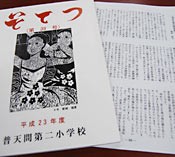
July 13, 2012 Yoshiya Hokama of Ryukyu Shimpo
The U.S. Marine Corps’ plan for the deployment of the MV-22 Osprey vertical take-off and landing transport aircraft to Futenma Air Station in August has caused anxiety among pupils who go to the Futenma No. 2 Elementary School which is adjacent to Futenma Air Station in Ginowan City. One pupil says, “I am very worried that the Osprey deployment may cause serious accidents.” In the 2011 edition of Sotetsu, a collection of essays and poems written by pupils that the school publishes every year, pupils expressed a range of feelings from everyday life including their anxiety about the Osprey deployment and accidents related to the military.
Naoto Maenaka, who was in the sixth grade in 2011, wrote about the anxiety he felt when he had to cover his ears during class each time there was an ear-splitting noise from military aircraft and his worry when he watched news about the Osprey deployment.
After a helicopter crashed onto the Okinawa International University, Maenaka started to take the his school’s annual evacuation drills much more seriously. He concluded his essay by writing, “I really hope that the Futenma Air Station will be moved out of Okinawa.”
Miu Watanabe, in the sixth grade at that time, recalled seven years ago when she entered Futenma No. 2 Kindergarten and for the first time saw an airplane that flew right above her. She wrote, “I was so scared because it seemed to be flying right at me.” However, in the last seven years she has become accustomed to such abnormal things happening every day. She says, “You cannot live your life unless you get used to it, but I hope that we can remove that problem as soon as possible. I want to have a quieter environment.” With regard to the Osprey deployment, she cautions not to become accustomed to it, stating that it would be more dangerous if we just get used to it, and forget the risk it poses. I am terrified that an airplane crash might happen.”
In addition, there were many poems and writings that address military issues and hope for peace. There were comments such as “I hope the military base issue will be resolved soon,” “I hope the noise of airplanes will go away,” and “I want a peaceful planet without wars.”
School principal at that time Harumi Chinen says, “There are pupils who become really frightened by an aircraft overhead. If they did not fly here, the children would not write these essays and poems. They sense the danger and are aware of the problem.”
(English translation by T&CT, Megumi Chibana and Mark Ealey)
Go to Japanese
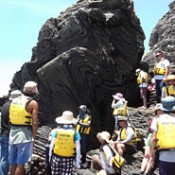
July 11, 2012 Ryukyu Shimpo
To mark the Kayo Fold (metamorphic rock) being designated as a national natural treasure, on July 5, at Teniya in Nago, on a trial basis the Wansaka Oura Park held a metamorphic rocks-viewing tour. A total of 21 people including municipal office officials, local residents and guides took part in the canoe tour, and the park will open it up to the public by the end of August, once the content is further enhanced after receiving comments from the initial round of participants.
The park planned the tour as a part of efforts to revitalize the local area that take advantage of the natural treasures certified by the national government.
In an explanatory session before the tour starts, it was explained that the unique fold of metamorphic rock is the result of pressure on the strata from various directions over tens of millions of years.
From Teniya it took about 40 minutes paddling across the sea full of coral in a canoe to reach the fold of metamorphic rock. After the participants got to the site, they said things like, “I was really moved by such an awe-inspiring place,” “I was impressed that the earth is a living thing,” “I felt a sense of romance about the place,” and one person who saw coral under the water said, “I really enjoyed the sea, the sky and the natural surroundings.”
Staff member of the Wansaka Oura Park Mitsunaga Oshiro who put the tour together, said, “This time, we went around Teniya but from now on I would like to organize similar programs at other sites on the east coast side in Nago.”
The timetable and prices of the canoe tour will be set in future, but for further information, please visit the official website: http://wansaka.ti-da.net/
(English translation by T&CT, Lima Tokumori and Mark Ealey)
Go to Japanese
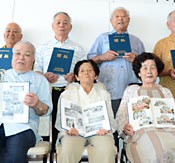
July 12, 2012
To mark the 50th anniversary of the settlement of Nosoko Sakae, Ishigaki City from the main island of Okinawa, histories and experiences of pioneers who moved into the area as immigrants sent by the Ryukyu Government, were compiled into a book called Kaitaku. On June 24, Ishigaki-shi Nosoko Sakae Kyoyukai, which is made up of immigrants who eventually returned to the main island of Okinawa, held a publication celebration party at Fisherman’s Wharf in Yomitan Village.
In 1954, 77 people from the main island of Okinawa settled in Sakae. The pioneers faced many challenges such as typhoon damage, malaria, and damage caused by wild boars as they worked on pineapple and sugar production.
Many immigrants began to return to the main island of Okinawa around the time of Okinawa’s reversion to Japanese administration in 1972. From that point on, the population of 476 people in 1964 rapidly declined. As of 2010, in Sakae approximately 70 people in 40 households made a living through agriculture such as pineapple growing.
To mark the 50th anniversary of the settlement, the book includes pictures and newspaper articles of the time, as well as records of meetings, and of a ceremony held in 2004 in Sakae.
Eighty-two year-old Hidemasa Iha who migrated as a pioneer and returned to the mainland in 1974 said, “Moving there led to a great deal of hardship, but the things that I have done have become the key things in my life. I don’t regret settling there.”
President Toyama of the Kyoyukai said, “Fifty-three people from Okinawa participated in the anniversary ceremony. We would like to maintain and deepen exchanges with our friends in Sakae.”
A book is available for 5000 yen. For more information, contact Tsugukazu Higa at 098-956-8587.
(English translation by T&CT, Megumi Chibana and Mark Ealey)
Go to Japanese











 Webcam(Kokusai Street)
Webcam(Kokusai Street)


